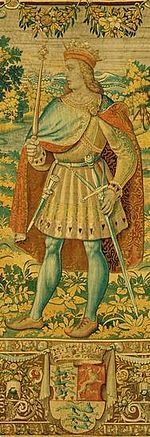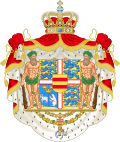- Olaf II of Denmark
-
For the anti-king of Denmark who called himself Olaf II, see Olaf Haraldsen.
Olaf II and IV King of Denmark, Norway, the Wends and the Goths; True Heir of Sweden 
Olaf II depicted on the Kronborg Tapestries (Kronborg Castle) King of Denmark Reign 3 May 1376 – 23 August 1387 (11 years, 112 days) Predecessor Valdemar IV Successor Margaret I King of Norway Reign 29 July 1380 – 23 August 1387 (7 years, 25 days) Predecessor Haakon VI Successor Margaret I Full name Danish: Oluf Håkonsen
Norwegian: Olav HåkonssonHouse Bjelbo Father Haakon VI of Norway Mother Margaret I of Denmark Born December 1370
Akershus Castle, OsloDied 23 August 1387 (aged 16)
Falsterbo Castle, FalsterboBurial Sorø Abbey, Sorø, Denmark Religion Roman Catholicism Olaf II Haakonsson (1370 – 23 August 1387) was king of Denmark as Olaf II (1376–1387) and king of Norway as Olaf IV (1380–1387). Olaf was son of King Haakon VI of Norway and the grandson of King Magnus IV of Sweden. His mother was Queen Margaret I of Denmark which made him the grandson of King Valdemar IV of Denmark. In addition to his claim on the thrones of Denmark and later Norway, he was in the direct succession line to the throne of Sweden (but for the interposition of Albert of Mecklenburg).[1]
He became king of Denmark only five years old and when he later also succeeded his father as king of Norway. For over 400 years that followed, Norway would be ruled from Denmark, until its separation from that country in 1814.
Contents
Biography
When his grandfather Valdemar IV of Denmark died, Olaf was just five years old. He was proclaimed King of Denmark by a Danehof in Slagelse the following year. His mother, Queen Margaret, was to serve as regent due to his young age. His proclamation included the title "true heir of Sweden" added at his mother's insistence since his grandfather had been king of Sweden until forced to abdicate. Olaf was hailed as king in Scania, including the towns controlled by the Hanseatic league since the Treaty of Stralsund in 1370. Queen Margaret signed a coronation charter on behalf of Olaf who was too young to rule until he came of age at fifteen. In the charter Olaf agreed to meet with the Danehof at least once a year and return properties his grandfather Valdemar IV had confiscated during his reign.[2]
Olaf became King of Norway on his father's death in 1380. Even when Olaf reached his majority in 1385, his mother ruled through him. With his ascent to the Norwegian throne, Denmark and Norway were thus united in a personal union ruled from Denmark. Denmark and Norway would have the same king, with the exception of short interregnums, until Norway's independence in 1814.
Despite all the hope Margaret and the peoples of Denmark, Norway, and Sweden had for Olaf's future, they were never realized. He died unexpectedly in 1387 at age 17. He was buried at Sorø Abbey on the Danish island of Zealand where also his grandfather and, later, mother was buried. Rumors immediately arose that Olaf had been poisoned which gave rise to many years later to the story of "false Olaf" (see below).
Following his death at Falsterbohus, Olaf's mother was proclaimed "all powerful lady and mistress and the Kingdom of Denmark's Regent". Denmark had at the time no provision that enabled a woman to rule in her own right. The next year Norway proclaimed her Norway's "reigning queen". After the defeat and overthrow of King Albert in 1389 she was proclaimed "all powerful lady of Sweden". On 13 June 1397, she was able to unite the three Scandinavian kingdoms in a personal union under one crown for her successor Eric of Pomerania by the Kalmar Union.[3]
After Olaf, no Norwegian king was to be born on Norwegian soil for more than 550 years, until prince Harald was born in 1937. Olaf's death was also the end of the male line of the Bjelbo dynasty in Sweden.
The false king Olaf
Prussian historian Johan von Posilge reported that in 1402 a "poor sick man came to the country and stayed near the village of Grudziądz. A group of merchants from Denmark asked him if he was not well known in Denmark, since he looked very much like the late King Olaf. The merchants left to find another who had seen the king and returned with him. When the newcomer saw the one they took for Olaf, he cried out, "My lord king!" Many people especially in Norway didn't believe that Olaf had died. They thought Queen Margaret had poisoned young Olaf to get him out of the way, so she could rule. According to the rumors, young Olaf hid himself and escaped. The news reached a merchant, Tyme von der Nelow, who took the man to Gdansk. The high born of the town welcomed Olaf as the rightful King of Denmark and Norway and gave him fine clothes and presents. A seal was made for him, and he wrote to Queen Margaret informing her that he was her son and demanded the restoration of his lands and titles. Queen Margaret wrote back saying that if he could prove himself her son, she would gladly accept him.
The Grand Master of the Teutonic Knights escorted the pretender to Kalmar to be interviewed by the Queen. As soon as the man arrived he was discovered to be an impostor. He could speak not a single word of Danish and on questioning admitted he was a Prussian who was the son of peasants: Adolph and Margaret from Eger. The false Olaf was taken to Lund in Scania. There he admitted to his breach against the monarchy and was condemned to be burned at the stake. The letters he wrote to Queen Margaret were hung around his neck and a mock crown placed on his head before he was lowered into the flames. His possessions were given to a monastery, and the queen had the false Olaf's seal destroyed. The Danish National Council released a detailed explanation of the real Olaf's death in 1387 to contradict the story that had spread around the Baltic.[4][5]
Ancestry
Ancestors of Olaf II of Denmark 16. Magnus III of Sweden 8. Eric, Duke of Södermanland 17. Hedwig of Holstein 4. Magnus IV of Sweden 18. Haakon V of Norway 9. Ingeborg of Norway 19. Euphemia of Rügen 2. Haakon VI of Norway 20. Guy of Dampierre 10. John I, Marquis of Namur 21. Isabelle of Luxembourg 5. Blanche of Namur 22. Philip of Artois 11. Marie of Artois 23. Blanche of Brittany 1. Olaf II of Denmark 24. Eric V of Denmark 12. Christopher II of Denmark 25. Agnes of Brandenburg 6. Valdemar IV of Denmark 26. Bogislaw IV, Duke of Pomerania 13. Euphemia of Pomerania 27. Margaret of Rügen 3. Margaret I of Denmark 28. Valdemar IV, Duke of Schleswig 14. Eric II, Duke of Schleswig 29. Elisabeth of Saxe-Lauenburg 7. Helvig of Schleswig 30. Henry I, Count of Holstein-Rendsburg 15. Adelheid of Holstein 31. Heilwig von Bronckhorst References
- ^ Olav 4 Håkonsson – utdypning (Store norske leksikon)
- ^ Danmarks Historie IIwww.perbenny.dk
- ^ Huitfeldt, Arild. Danmarks riges Krønike
- ^ Rosborn+ När hände vad i nordens historia 1996. p.69.ISBN 91-7643-350-1
- ^ Williams, Gareth.Sagas,Saints,and Settlements.
Other sources
- Albrectsen, Esben Danmark-Norge 1380-1814. B. 1 Fællesskabet bliver til : 1380-1536 (Danske historiske forening. 1981)
Olav IV/Olaf IIBorn: 1370 Died: 23 August 1387Regnal titles Preceded by
Valdemar AtterdagKing of Denmark
1376–1387Succeeded by
Margaret IPreceded by
Haakon VI MagnussonKing of Norway
1380–1387Titles in pretence Preceded by
Albrekt of Mecklenburg— TITULAR —
King of Sweden
pretender
1385–1387
Reason for succession failure:
Died while Albrekt of Mecklenburg
was still King of SwedenSucceeded by
Margaret IMonarchs of Denmark Early monarchs c.916–1412(Harthacnut) · Gorm the Old · Harald Bluetooth · Sweyn Forkbeard1 · Harald II · Cnut the Great1 · Harthacanute1 · Magnus the Good · Sweyn II · Harald III · Canute the Saint · Olaf I · Eric Evergood · Niels · Eric the Memorable · Eric Lamb · Sweyn Grathe / Canute V / Valdemar the Great · Canute VI · Valdemar the Victorious / Valdemar the Young · Eric Plough-tax · Abel · Christopher I · Eric Klipping · Eric Menved · Christopher II · Valdemar III · Christopher II · Interregnum · Valdemar Atterdag · Olaf II · Margaret I2
Palatinate-Neumarkt 1397–1448Oldenburg 1448–1863Christian I2 · John2 · Christian II2 · Frederick I · Christian III · Frederick II · Christian IV · Frederick III · Christian V · Frederick IV · Christian VI · Frederick V · Christian VII · Frederick VI · Christian VIII · Frederick VIISchleswig-Holstein-
Sonderburg-Glücksburgsince 1863Categories:- Danish monarchs
- Norwegian monarchs
- Swedish princes
- Medieval child rulers
- Burials at Sorø Abbey
- 1370 births
- 1387 deaths
- Roman Catholic monarchs
Wikimedia Foundation. 2010.

